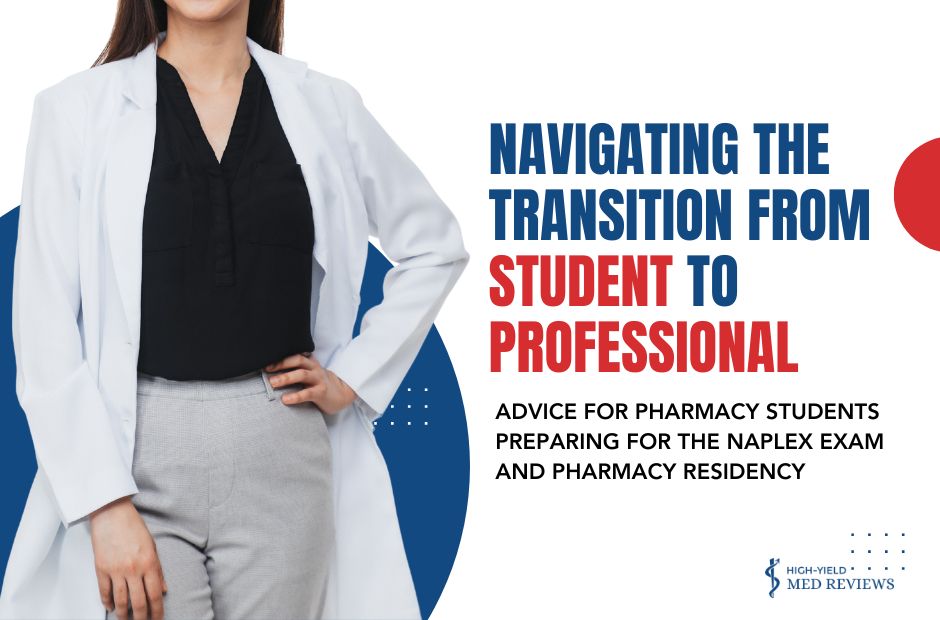Navigating the Transition from Student to Professional
ADVICE FOR PHARMACY STUDENTS PREPARING FOR THE NAPLEX EXAM AND PHARMACY RESIDENCY
Guest Contributor Micaela Hayes, PharmD is a recent PGY2 pharmacy residency graduate who successfully navigated her APPE rotations, passed the NAPLEX exam, and matched with her number one pharmacy residency program in Phase I of the ASHP Match.
My NAPLEX Exam Journey
When I started my pharmacy practice experience (APPE) rotations during my fourth year of pharmacy school, the daunting prospect of passing the NAPLEX exam, succeeding in the PGY1 pharmacy residency application process, and successfully navigating my APPE rotations loomed large on my mind. To quell the stress, I crafted a meticulous study plan, aligning it with my rotations to maximize efficiency. This preparation ended up paying off significantly during my internal medicine rotation when a complex medical question arose during rounds relating to a patient's antibiotic therapy. Thanks to diligently aligning my NAPLEX study schedule with my rotation, I had recently reviewed a topic relating to infectious disease. Drawing from information I had reviewed in the Rapid Review books, I was able to easily outline my plan regarding a patient's antibiotic regimen and what factors influenced my decision-making process. This moment affirmed the efficacy of my approach, highlighting how strategic preparation directly translated into success on rotation.
Challenges Presented to Pharmacy Students During Their APPE Year
Stepping into your Advanced Pharmacy Practice Experiences (APPE) marks a pivotal step toward becoming a clinical pharmacist. Navigating the landscape of your APPE rotations, preparing for the NAPLEX exam, and undertaking the complexities of PGY1 pharmacy residency applications can present a challenging transition into your career.
The dynamic landscape of this year requires proficient time management skills and organization abilities. As if the demands of this year weren't enough, the current trend of falling NAPLEX pass rates paired with the competitive environment of the PGY1 pharmacy residency application process adds additional layers of stress for pharmacy students.
In this dynamic environment, it's crucial for aspiring clinical pharmacists to:
- Implement self-reflection
- Integrate advantageous tools
- Leverage valuable resources
- Seek mentorship
- Take control of this transition year by creating a robust plan for their success

I'm excited to share my personal experience in successfully preparing for the NAPLEX and provide advice to aspiring clinical pharmacists on how to successfully traverse their APPE rotations while pursuing PGY1 pharmacy residency.
Invest in the right tools
The NAPLEX is a final hurdle between you and your pharmacy career. Master this exam by implementing a structured study approach that encompasses an organized study plan, allowing ample time to implement the plan, investing in proven resources, and integrating strategies to help you succeed. I chose to invest in the High-Yield NAPLEX Exam Review, which was an extremely helpful resource that contributed to my success on the exam. The program offers a multidimensional learning approach that includes Rapid Review Books for focused topic reviews, 300 focused Lecture Topics with lecture notes, over 2,500 NAPLEX Q-bank practice questions, practice exams, and Integrated Case-Based Review Webinars.
Strategies for success
Implementing the following strategies was extremely helpful in maximizing my time and energy while preparing for the NAPLEX exam and my APPE rotations. The time efficiency strategies were critical for me to thoroughly prepare my PGY1 pharmacy residency application materials and attend residency showcase events. I also used this spare time to acquire knowledge and skills to become the strongest residency candidate possible and successfully navigate the PGY1 pharmacy residency process, securing a residency position with my top-choice in Phase I of the American Society of Health System Pharmacists (ASHP) Match.
-
Map Out an Organized Study Plan: Create a long-term study plan that spans your entire APPE year. Incorporate focused topic and lecture reviews along with knowledge application opportunities through practice questions (Q-Bank questions), practice exams, and applying the knowledge on rotations. Next, create a condensed review beginning four to six weeks before your NAPLEX exam date. Focus this review using your performance throughout your long-term study plan and create it as you navigate through your long-term study plan.
-
Maximize Your Time - Align Your Study Plan and APPE Rotations: Amplify your efforts by aligning your NAPLEX study schedule with your APPE rotations. Aim to study rotation-related pharmacotherapy topics before and throughout the rotation. This helps you succeed on rotation, builds your confidence in different pharmacotherapy topics for the NAPLEX, and enhances opportunities for practical application of your knowledge to allow for a more comprehensive understanding of clinical topics, rather than just memorizing facts.
-
Practice Makes Perfect: Implementing a daily practice of answering practice questions and strategically integrating practice exams into my study schedule was key in adequately preparing for my exam. This helps to test knowledge comprehension, identify areas of strength and weakness, understand and assess your readiness for the exam, and helps to build testing stamina. I found High-Yield's Q-Bank questions extremely valuable. They align with the NAPLEX exam objectives provided by the National Association of Boards of Pharmacy (NABP), are written by pharmacy faculty and practicing pharmacists, and include peer performance comparison insight for each question. After answering each question, the answer is displayed along with the rationale for why the answer is correct and why the additional choices are incorrect. Each question also provides the core concepts, fast facts, and references associated with the question.
-
Time Management Tip - Leverage Fringe Hours: Use your rotation commute to listen to lectures. I would do this to stay on track with my study schedule or use it as a last-minute review to boost my confidence for that day's rotation activities (i.e., topic discussions, journal clubs, case presentations, etc.). One of the most valuable time-hacks I learned during my APPE year was how to leverage fringe hours to maximize my productivity. If you're waiting in line, getting ready for the day ahead, going for a run, or stuck in traffic, maximize this time by consuming lecture topics, podcasts, audiobooks, and videos that can help advance your future.
-
Utilize Rapid Review and Top Drugs books to Prepare for Rotation Assignments: When preparing for rotation topic discussions, journal clubs, case presentations, and other rotation assignments, I used the topic reviews in my Rapid Review Books. Even if I had previously reviewed the topic, it helped to use the Rapid Review Books to refresh myself on the material which led to further comprehension of important concepts and provided additional opportunities for knowledge application and retention. In my experience, concept repetition and application were crucial to my success on the NAPLEX.
-
Application Bridges Theory to Practice: The NAPLEX includes complicated case-based questions. Participating in Integrated Case-Based Review Webinars helped develop the muscle of advanced application opportunities of core concepts to clinical cases. These webinars helped me bridge theoretical knowledge with real-world cases, providing additional opportunities to assess my comprehension of key clinical concepts for my exam and future clinical practice. My High-Yield course included six webinars that allowed me to systematically integrate core content into the diverse clinical cases. Whatever study materials you are using, I would encourage you to find case-based reviews that will force you to stretch your understanding and consider how to apply what you are studying to more complex cases.
Pro Tip: The "My Performance" tool, offered in the High-Yield NAPLEX Review, is a great resource to help create your condensed review. It identifies categories of strengths and weaknesses based on your results from the Q-Bank questions and practice exams.
Pro Tip: A major key to my success as a pharmacy residency candidate was consuming as much information as I could through podcasts, videos, and audiobooks about the pharmacy residency process and how to attain skills and knowledge to be a strong residency candidate. This habit led me to residency mentors who invested in my success, along with other resources I invested in, which resulted in my success as an aspiring pharmacy resident.
Lastly, cross the finish line with confidence
If you create a study plan, maximize your time, and use a variety of tools to learn, practice and apply the content you are studying, you can walk confidently into your NAPLEX exam and finish strong. In addition to closing your time as a student, you will be well-prepared to enter the exciting world of pharmacy as a competent pharmacist.
Additional Resources You Might Like
Blog: Proven Strategies to Crush the MPJE
Blog: 3 Ways to Leverage APPE Rotations for NAPLEX Prep
Blog: What's on the NAPLEX Exam?



